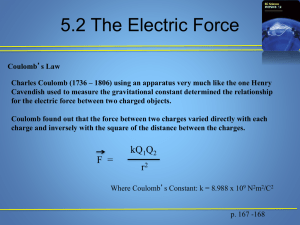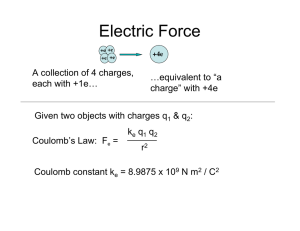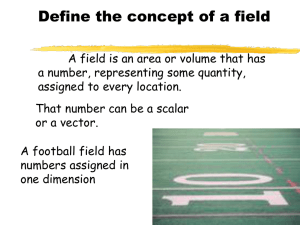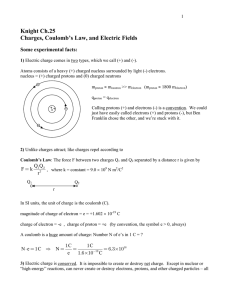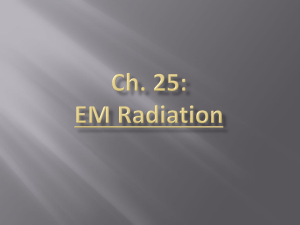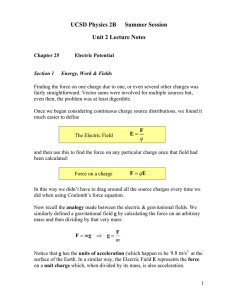PPT - LSU Physics & Astronomy
advertisement
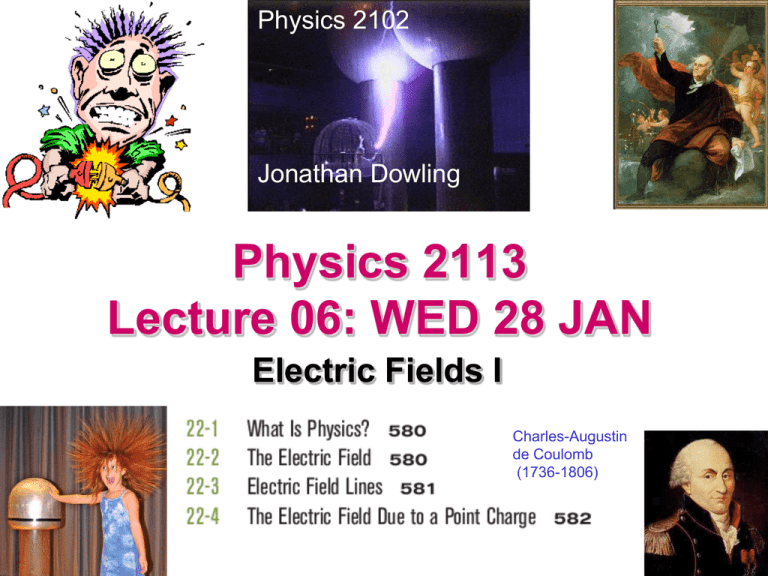
Physics 2102 Jonathan Dowling Physics 2113 Lecture 06: WED 28 JAN Electric Fields I Charles-Augustin de Coulomb (1736-1806) What Are We Going to Learn? A Road Map • Electric charge - Electric force on other electric charges - Electric field, and electric potential • Moving electric charges : current • Electronic circuit components: batteries, resistors, capacitors • Electric currents - Magnetic field - Magnetic force on moving charges • Time-varying magnetic field & Electric Field • More circuit components: inductors. • Electromagnetic waves - light waves • Geometrical Optics (light rays). • Physical optics (light waves) Coulomb’s Law + q1 F12 F21 r12 k | q1 | | q2 | | F12 |= 2 r12 -q2 For Charges in a Vacuum 2 N m 9 8 . 99 ´ 10 k= C2 Often, we write k as: k= 1 4pe 0 Charles-Augustin de Coulomb (1736-1806) with e 0 = 8.85 ´ 10 -12 2 C N m2 Sir Michael Faraday’s Electric Lines of Force Electric Force Field Faraday (1791–1867) E-Field is E-Force Divided by E-Charge Definition of Electric Field: EForce on Charge +q1 –q2 P1 P2 E-Field at Point –q2 P1 Units: F = [N] = [Newton] ; P2 E = [N/C] = [Newton/Coulomb] Electric Fields • Electric field E at some point in space is defined as the force experienced by an imaginary point charge of +1 C, divided by 1 C. • • • Note that E is a VECTOR. Electric Field of a Point Charge Since E is the force per unit charge, it –q E +1C is measured in units of N/C. R We measure the electric field using very small “test charges”, and dividing the measured force by the magnitude of the charge. k |q| | E |= 2 R Compare to Gravitational to Electric Fields Gravitational Force: (Units: Newtons = N) GmM F=- 2 r (Units: N/kg) GM g=- 2 r Given the Field, Find the Force: F = mg Gravitational Field: Find the Force: (Vector Form) Electric Force: (Units: Newtons = N) Electric Field: (Units: N/C) Given the Field, Find the Force: Find the Force: (Vector Form) kqQ F= r2 kQ E= 2 r F = qE Compare to Electric Field to Gravitational Field Gravitational Field Lines m r̂ Note: Field Exists in Empty Space Whether Test Mass m is There or Not! Electric Field Lines +q r̂ Note: Field Exists in Empty Space Whether Test Charge +q is There or Not! Electric Field Lines • Field lines: useful way to visualize electric field E • Field lines start at a positive charge, end at negative charge • E at any point in space is tangential to field line • Field lines are closer where E is stronger Example: a negative point charge — note spherical symmetry Direction of Electric Field Lines E-Field Vectors Point Away from Positive Charge — Field Source! E-Field Vectors Point Towards Negative Charge — Field Sink! ICPP Superposition of F and E • Question: How do we figure out the force or field due to several point charges? • Answer: consider one charge at a time, calculate the field (a vector!) produced by each charge, and then add all the vectors! (“superposition”) • Useful to look out for SYMMETRY to simplify calculations! • If you never learned to add vectors in 2101 you’ll be in serious trouble in 2102! See online review http://phys.lsu.edu/~jdowling/ PHYS21024SP10/Vectors.pdf ICPP Total electric field -2q +q • 4 charges are placed at the corners of a square as shown. • What is the direction of the electric field at the center of the square? (a) Field is ZERO! (b) Along +y (c) Along +x -q y +2q +q º +1.0C +q is the test charge x ICPP: Which Way is Enet?



